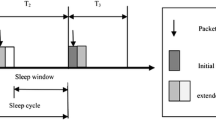Abstract
The IEEE 802.16e standard is an emergent broadband wireless access technology that added the mobility feature to the original standard. This feature made battery life of an operated mobile subscribe station (MSS) a bigger challenge because an MSS is powered by a rechargeable battery. The battery lifetime mechanism has to be created in order to prolong the battery-life of an MSS. The battery lifetime-aware power saving (BLAPS) scheme has been created to prolong the battery life of an MSS by adaptively adjusting the three-sleep parameters named idle threshold, initial sleep window, and final sleep window according to the residual energy and the traffic load. However, the scheme minimized the energy consumption of the MSS at the expense of the average response delay due to the effect of the remaining energy. It also used the standard sleep mode algorithm where the MSS frequently goes to listening mode when the traffic is low which leads to the high-energy consumption. In this paper, a new energy mechanism called efficient battery life-aware power saving scheme has been proposed to enhance the parameters of BLAPS. The three-sleep parameters in BLAPS mechanism are analytically enhanced according to the downlink stochastic traffic arrival pattern of an MSS. Moreover, an improved sleep mode control algorithm has been introduced to reduce the frequent transition to listening mode in case of low traffic. The simulation has been extensively used to evaluate the proposed scheme. The results have shown that the proposed scheme outperforms the BLAPS significantly in terms of both the average response delay and the average energy consumption.












Similar content being viewed by others
References
IEEE Standard for Local and Metropolitan Area Networks, Part 16: Air Interface for Fixed Broadband Wireless Access Systems, IEEE 802.16 Working Group and others, IEEE Std, 802,16-2004 2004.
IEEE Standard for local and metropolitan area networks Part 16: Air interface for fixed and mobile broadband wireless access systems amendment 2: Physical and medium access control layers for combined fixed and mobile operation in licensed bands and corrigendum 1, IEEE LAN/MAN Standards Committee and others, IEEE std, 802 2005.
Xiao, Y. (2005). Energy saving mechanism in the IEEE 802.16e wireless MAN. IEEE Communications Letters, 9, 595–597.
Xiao, Y. (2006). Performance analysis of an energy saving mechanism in the IEEE 802.16 e wireless MAN. In 3rd IEEE consumer communications and networking conference (CCNC) (Vol. 1, pp. 406–410), IEEE.
Zhang, Y., & Fujise, M. (2006). Energy management in the IEEE 802.16 e MAC. IEEE Communications Letters, 10, 311–313.
Xiao, J., Zou, S., Ren, B., & Cheng, S. (2006). WLC17-6: an enhanced energy saving mechanism in IEEE 802.16 e. In IEEE global telecommunications conference, 2006. (GLOBECOM’06) (pp. 1–5), IEEE.
Zhu, S., & Wang, T. (2007). Enhanced power efficient sleep mode operation for IEEE 802.16 e based WiMAX. In IEEE mobile WiMAX symposium, 2007 (pp. 43–47), IEEE.
Liu, J., Ren, F., & Lin, C. (2010). A dual-threshold power saving mechanism in WiMAX. In 2010 IEEE/ACIS 9th international conference on computer and information science (ICIS) (pp. 465–470), IEEE.
Xu, F., Zhong, W., & Zhou, Z. (2006). A novel adaptive energy saving mode in IEEE 802.16 e system. In IEEE military communications conference on 2006 (MILCOM 2006) (1–6), IEEE.
Vatsa, O. J., Raj, M., Ritesh Kumar, K., Panigrahy, D., & Das, D. (2007). Adaptive power saving algorithm for mobile subscriber station in 802.16e. In 2nd International conference on communication systems software and middleware, 2007 (COMSWARE 2007) (pp. 1–7), IEEE.
Chou, L.-D., Li, D. C., & Hong, W.-Y. (2013). Improving energy-efficient communications with a battery lifetime-aware mechanism in IEEE802. 16e wireless networks. In Concurrency and computation: Practice and experience (vol. 25, 94–111), Wiley Online Library.
Zhu, S., Ma, X., & Wang, L. (2007). A delay-aware auto sleep mode operation for power saving WiMAX. In Proceedings of 16th international conference on computer communications and networks, 2007 (ICCCN 2007) (pp. 997–1001), IEEE.
Kim, M.-G., Choi, J., & Kang, M. (2008). Adaptive power saving mechanism considering the request period of each initiation of awakening in the IEEE 802.16 e system. IEEE Communications Letters, 12(2), 106–108.
Xue, J., Yuan, Z., & Zhang, Q. (2008). Traffic load-aware power-saving mechanism for IEEE 802.16 e sleep mode. In 4th International conference on wireless communications, networking and mobile computing, 2008 (WiCOM’08) (pp. 1–4), IEEE.
Sanghvi, K., Jain, P. K., Lele, A., & Das, D. (2008). Adaptive waiting time threshold estimation algorithm for power saving in sleep mode of IEEE 802.16e. In 3rd International conference on communication systems software and middleware and workshops, 2008 (COMSWARE 2008) (pp. 334–340), IEEE.
Kim, M.-G., Kang, M., & Choi, J. Y. (2008). Remaining energy-aware power management mechanism in the 802.16e MAC. In 5th IEEE consumer communications and networking conference, 2008 (CCNC 2008) (pp. 222–226), IEEE.
Lin, Y.-W., & Wang, J.-S. (2013). An adaptive QoS power saving scheme for mobile WiMAX. Wireless personal communications, 69(4), 1435–1462.
Ferng, H.-W., & Li, H.-Y. (2013). Design of predictive and dynamic energy-efficient mechanisms for IEEE 802.16e. Wireless Personal Communications, 68(4), 1807–1835.
Meng, L., Han, S., Yu, K., & Chao, Y. (2012). Research on sleep mode in WANDAS. Instrumentation, Measurement, Circuits and Systems, 127, 127–136.
Author information
Authors and Affiliations
Corresponding author
Rights and permissions
About this article
Cite this article
Saidu, I., Subramaniam, S., Jaafar, A. et al. An Efficient Battery Lifetime Aware Power Saving (EBLAPS) Mechanism in IEEE 802.16e Networks. Wireless Pers Commun 80, 29–49 (2015). https://doi.org/10.1007/s11277-014-1993-7
Published:
Issue Date:
DOI: https://doi.org/10.1007/s11277-014-1993-7




